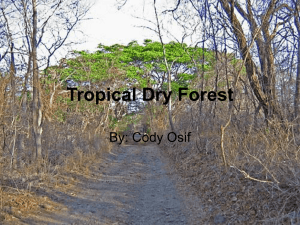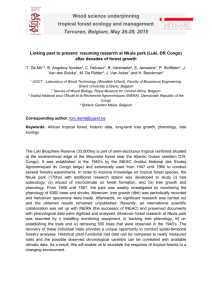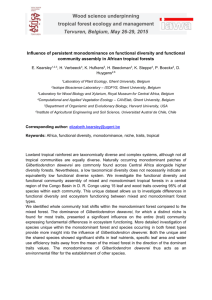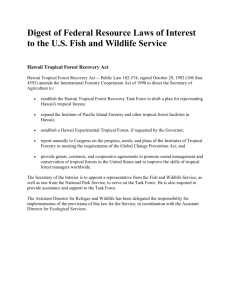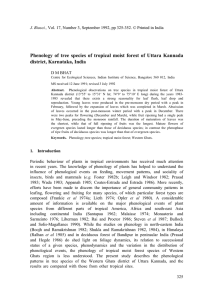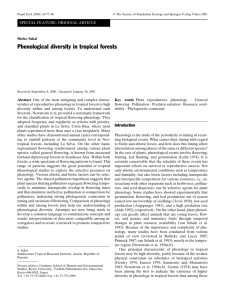Mélaine AUBRY
advertisement
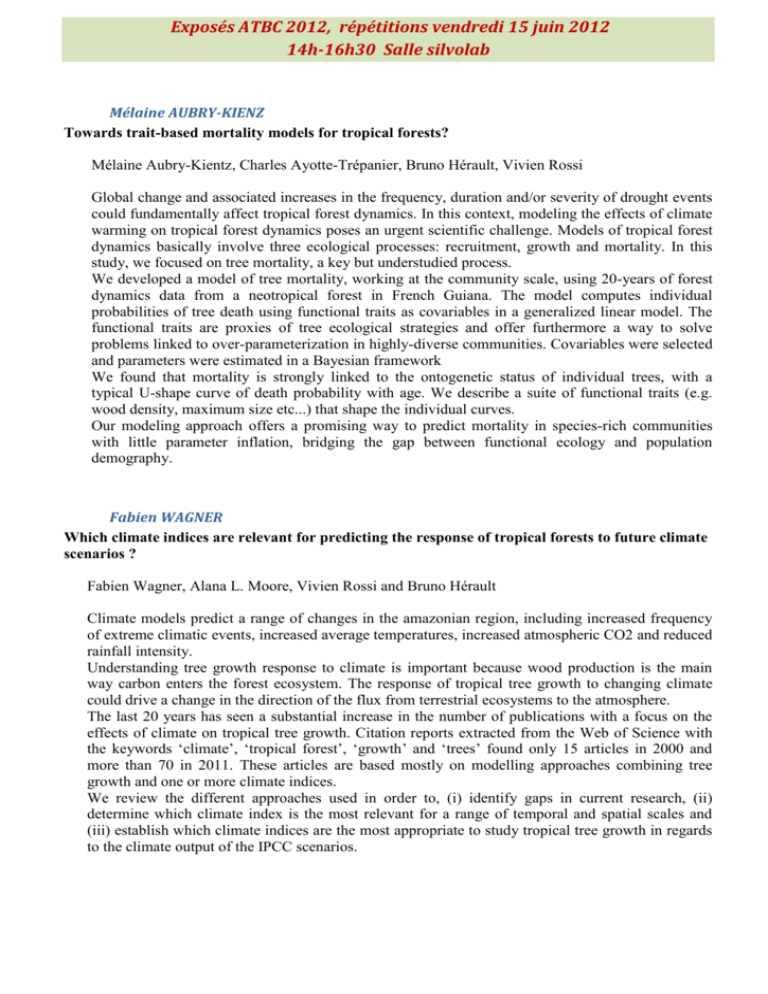
Exposés ATBC 2012, répétitions vendredi 15 juin 2012 14h-16h30 Salle silvolab Mélaine AUBRY-KIENZ Towards trait-based mortality models for tropical forests? Mélaine Aubry-Kientz, Charles Ayotte-Trépanier, Bruno Hérault, Vivien Rossi Global change and associated increases in the frequency, duration and/or severity of drought events could fundamentally affect tropical forest dynamics. In this context, modeling the effects of climate warming on tropical forest dynamics poses an urgent scientific challenge. Models of tropical forest dynamics basically involve three ecological processes: recruitment, growth and mortality. In this study, we focused on tree mortality, a key but understudied process. We developed a model of tree mortality, working at the community scale, using 20-years of forest dynamics data from a neotropical forest in French Guiana. The model computes individual probabilities of tree death using functional traits as covariables in a generalized linear model. The functional traits are proxies of tree ecological strategies and offer furthermore a way to solve problems linked to over-parameterization in highly-diverse communities. Covariables were selected and parameters were estimated in a Bayesian framework We found that mortality is strongly linked to the ontogenetic status of individual trees, with a typical U-shape curve of death probability with age. We describe a suite of functional traits (e.g. wood density, maximum size etc...) that shape the individual curves. Our modeling approach offers a promising way to predict mortality in species-rich communities with little parameter inflation, bridging the gap between functional ecology and population demography. Fabien WAGNER Which climate indices are relevant for predicting the response of tropical forests to future climate scenarios ? Fabien Wagner, Alana L. Moore, Vivien Rossi and Bruno Hérault Climate models predict a range of changes in the amazonian region, including increased frequency of extreme climatic events, increased average temperatures, increased atmospheric CO2 and reduced rainfall intensity. Understanding tree growth response to climate is important because wood production is the main way carbon enters the forest ecosystem. The response of tropical tree growth to changing climate could drive a change in the direction of the flux from terrestrial ecosystems to the atmosphere. The last 20 years has seen a substantial increase in the number of publications with a focus on the effects of climate on tropical tree growth. Citation reports extracted from the Web of Science with the keywords ‘climate’, ‘tropical forest’, ‘growth’ and ‘trees’ found only 15 articles in 2000 and more than 70 in 2011. These articles are based mostly on modelling approaches combining tree growth and one or more climate indices. We review the different approaches used in order to, (i) identify gaps in current research, (ii) determine which climate index is the most relevant for a range of temporal and spatial scales and (iii) establish which climate indices are the most appropriate to study tropical tree growth in regards to the climate output of the IPCC scenarios. Jérémie Lauth A mutualistic community of ants, plant and fungi: How a third partner affects plant biotic protection by ants Jérémie Lauth, Pierre-Jean G. Malé2, Céline Leroy, Olivier Roux, Alain Dejean and Jérôme Orivel In ant-plant mutualisms, the biotic protection of plants is ensured by the patrolling of ant workers on the leaves. However, because such plant defense emerges from the predatory behavior of the colonies, the biotic protection is considered as a by-product of selfish activities. To meet their need for nitrogen in the restricted foraging environment provided by their host plants, some plant-ants have developed alternative hunting techniques. This is the case for example in ants of the genus Allomerus, which cultivate a fungus to build galleries on the stems of their host plants they use as traps. If such predatory strategy enables the capture of prey larger than those the workers could capture on the foliage, it generates, however, a spatial segregation of the workers, which could reduce the conferred benefits to the plants. Here we explore this issue by quantifying several traits of the predatory strategies of two Allomerus species coexisting on the same host plant species, Hirtella physophora. These two ant species displayed significant differences, with the specialist ant A. decemarticulatus preferentially preying in the galleries and the generalist A. octoarticulatus on the leaves. Consequently, the plants inhabited by the ant A. octoacticulatus were better protected and, thus, experienced a higher vegetative growth and fruit production. Our results suggest that although A. octoarticulatus confers greater benefits to H. physophora, the higher specialization of A. decemarticulatus towards its host plant and the maintenance of positive outcome of their association through reciprocated investment seem to be sufficient to maintain an evolutionary stable interaction. Moreover, providing that the galleries could be used as a proxy of the strength of the fungal association, the integration of such protective mutualism in a larger community context highlights how additional partners may modulate the basic outcomes and the evolutionary mechanisms maintaining a bipartite mutualism. Céline LEROY Tank-bromeliads : under-studied freshwater micro-ecosystems in tropical rain forests Christopher BARALOTO Effects of road paving and land tenure on forest value in the tri-national frontier region of southwestern Amazonia Claire FORTUNEL Environmental filtering and species distributions across lowland South American forests Hélène MOREL Studying phenology through a morphological and anatomical retrospective analysis under tropical climate: An example on Parkia velutina Benoist (Mimosoïdeae). Most studies on tropical plant phenology have focused on patterns of flowering, fruiting and leafshedding. Field surveys are used in most studies, some of them relying on remote-sensing data. Phenological examinations of cambium are scarces, despite the importance of secondary growth to dendrochronology and retrospective growth-ring analysis. We studied primary and secondary growth at scales from within-individual to populations, using two complementary methods: a field survey and a retrospective analysis based on morpho-anatomical growth markers. We worked in French Guiana on Parkia velutina, an emergent tree of Neotropical rain forests. We collected dominant branches from 14 adults and identified growth markers that delimited longitudinal and radial increments. We coupled this retrospective analysis with a 2-year phenological survey of (i) leaf-shedding and growth on twenty trees every month and (ii) the repeated collection of microcores from five trees every fifteen days to determine intra-annual cambial activity (i.e. formation of secondary xylem). Successive growth units and growth rings were easily identifiable. These structural regularities traduce the phenological cycle defined by leaf shedding, growth-unit elongation and growth-ring formation. Within individual trees, we found this cycle to be synchronous across all growth axes. The cycle was essentially annual, with some slight variability. At the population scale, trees were unsynchronized. Primary and secondary growths were correlated: the peak of cambial activity occurred when leaves were mature. Conversely, little cambial activity occurred when leaves were senescent or young, or branches were leafless. Our study shows that retrospective analysis and field survey are two complementary approaches to understand plant phenology and to interpret morpho-anatomical structure. Dating a branch by counting the number of growth units or growth rings is possible in many years with a reasonable error. Nevertheless, estimating their precise month of formation in order to study climatic influences remains difficult.




